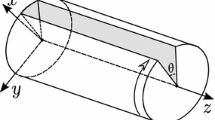Abstract
Linear complementarity problems (LCP) may be solved if their condition number, defined appropriately is positive. This paper presents a transformation for the LCP which satisfy mild conditions to a form which will have a positive condition number. For these extensive classes an Interior point method can be used to solve it.
Similar content being viewed by others
References
Di Giacomo L., Argento E., Patrizi G.: Linear complementarity methods for the solution of combinatorial problems. J. Comput. 19, 73–79 (2007)
Golub G.H., van Loan C.F.: Matrix Computations. The Johns Hopkins University Press, Baltimore, MD (1983)
Kojima M., Megiddo N., Ye Y.: An interior point potential reduction algorithm for the linear complementarity problem. Math. Program. 56, 285–300 (1992)
Ye Y.: Interior Point Algorithms: Theory and Analysis. Wiley, New York (1997)
Ye Y., Pardalos P.: Class of linear complementarity problems solvable in polynomial time. Linear Algebra Appl. 152, 3–17 (1991)
Author information
Authors and Affiliations
Corresponding author
Rights and permissions
About this article
Cite this article
Di Giacomo, L. An extension of interior point potential reduction algorithm to solve general LCPs. J Glob Optim 44, 553–561 (2009). https://doi.org/10.1007/s10898-008-9356-0
Received:
Accepted:
Published:
Issue Date:
DOI: https://doi.org/10.1007/s10898-008-9356-0



